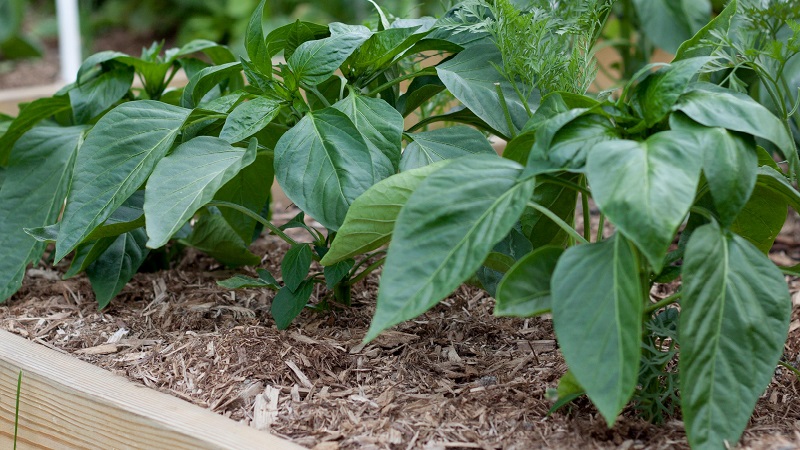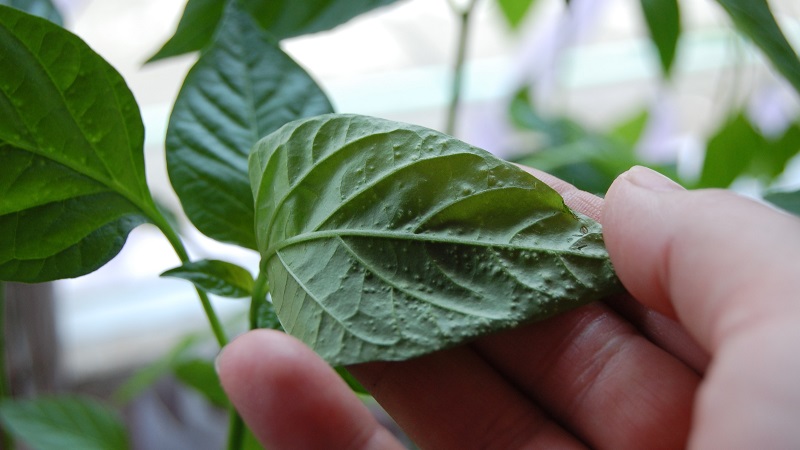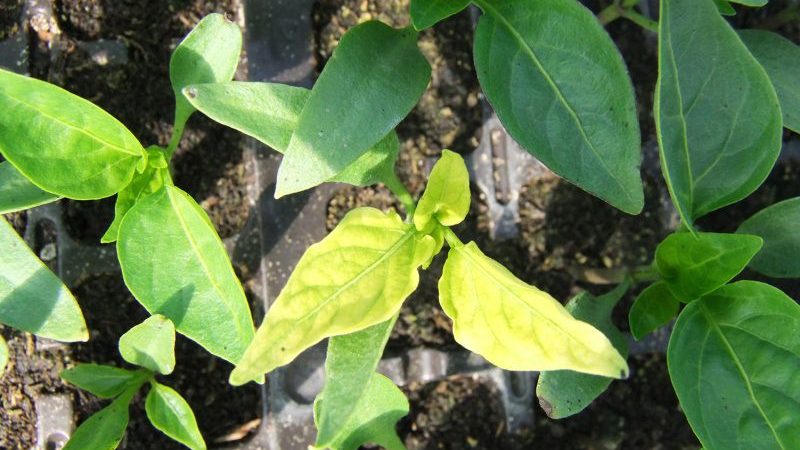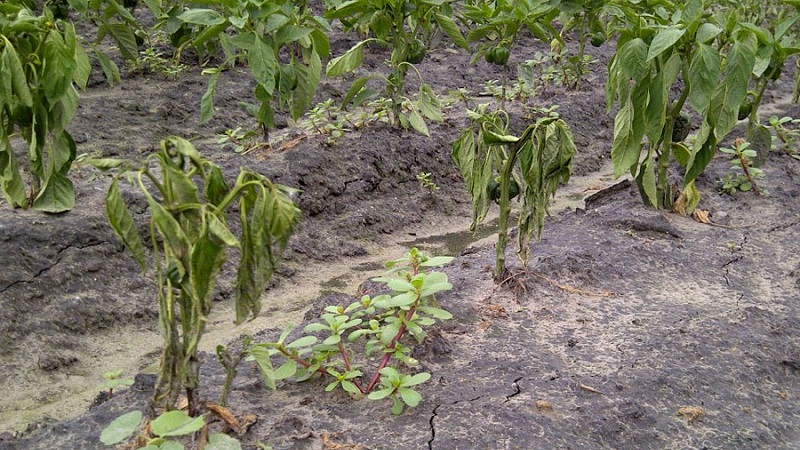Why do the leaves of peppers wither in the greenhouse and what to do to save your crop
When growing peppers in a greenhouse, gardeners often face the problem of leaf curling. This suggests that some mistakes were made during the cultivation. Having understood them and eliminating the causes of the disease in time, you can save the crop. So why the leaves of the peppers wither in the greenhouse and what to do in this case?
The content of the article
Possible causes of wilting pepper leaves in the greenhouse
At the first signs of twisting of pepper leaves, it is urgent to establish the cause. Many factors can lead to this: improper agricultural technology, inappropriate soil composition, stress after planting seedlings in a permanent place in the greenhouse, the presence pests and disease.
With untimely loosening of the beds, a crust forms on the ground, due to which the aeration of the root system is disturbed. The cessation of air access to the roots is evidenced by the appearance of the green mass. The leaf blades lose their elasticity, the edges curl towards the central vein.

Diseases
The cause of leaf wilting can be the disease phytoplasmosis (stolbur) - a fungal disease provoked by sudden changes in day and night temperatures in conditions of high humidity in the greenhouse. The carriers of the disease are spider mites and aphids. At first, the plant becomes covered with red-brown spots, the leaves curl. After irrigation, they lose their turgor and rot. The fruits grow small and misshapen. Taste is lost.
Late blight may appear in the greenhouse - a fungal disease, which is also facilitated by the humid climate of an enclosed space. Small brown spots appear on the leaves. Leaves curl and wither. Black moist areas appear on the fruit. Gradually, the plant dies.
If bacteria remain in the soil from the previous season, they cause verticillary wilting of the pepper. The leaves lose color, become rough and tough. The fruits grow small, deformed, with few seeds.
With fusarium wilting, the vascular system of the plant is affected. Plaques form in the vessels, clogging them, the movement of the juice stops. The leaves curl and dry up, the bush dies.
Pests
Greenhouse-grown peppers are not as susceptible to pests as in the open field, but some types of harmful insects still prefer a greenhouse climate - high humidity and warm air.
Most often, aphids parasitize in greenhouses. This small light midge appears more often if the soil has not been disinfected and the garden tools have not been treated with disinfectants before planting. The insect settles on the outside of the leaves. Larvae are visible on examination. The juice from the leaves serves as food for it. Losing moisture, the leaves curl, wither and fall off. If the plant was weakened for other reasons, aphid infestation leads to its death.
The spider mite, a scanty-sized bug (0.5 mm), causes great harm to the culture. The pest disguises itself as the color of various parts of the bush, changing its color from emerald to dark beige. It is not easy to notice it between the leaves. His presence is indicated by the presence of a thin web on the bush.The mite itself clings to the outside of the leaf blade and, piercing it, sucks out the juice. At the same time, the pest releases a liquid that is dangerous to plants. The affected leaves curl, the plant withers, the fruits deteriorate. The tick is capable of destroying the entire crop.
Whiteflies are common in greenhouses. Outwardly, the whitefly looks like a small white fly. The pest settles in flocks on the outside of the leaf. In places of its settlement, the leaves become sticky, the larvae are clearly visible on them. Insects also feed on the sap of the leaves, as a result of which the green mass of plants dries up.

Gardener mistakes
The culture reacts even to minor deviations from the rules of agricultural technology. If the growing conditions are not followed, the growth of the plant slows down, the development of the bush stops. The appearance of the leaves indicates the state of the plant.
Pepper is a moisture-loving culture. With insufficient watering, the green mass withers, the edges of the leaves curl, the leaf dries and falls off.
If the air in the greenhouse is too dry, this will affect the state of the foliage: it deforms, becomes gray.
Some beginners believe that it is enough to create a warm and humid climate in a greenhouse without paying attention to lighting. This error leads to a lack of light, as a result of which the bushes grow weak, with twisted leaves and thin twigs. The culture does not tolerate being in the shade and slowly dies from it.
If tomatoes or eggplants grew in the greenhouse in the previous season, spores of pathogenic fungi may remain in the soil, leading to damage to the pepper.
Sometimes, in order to get a large harvest, gardeners are addicted to mineral fertilizers in excess of the norm. Pepper reacts negatively to an excess of introduced elements. This is reflected in the appearance of the green mass.
The appearance of the leaves also indicates a deficiency of any element. With a lack of phosphorus, the lower part of the leaves becomes purple. With a lack of potassium, the leaves curl and turn yellow. If the plant lacks nitrogen, the leaves turn gray-green. To replenish the missing element, fertilizing is carried out on the sheet.
External factors
Sunburn is one of the external factors affecting the state of the foliage in the greenhouse.
It occurs when condensation collects on the leaves, which is exposed to a sunbeam. The temperature in this area of the leaf increases greatly, and dry, colorless spots are formed. The leaves curl and dry out. This happens especially often in low greenhouses.
Plants also get sick if soil was brought into the greenhouse from the site where the infected plants grew to create beds.
If non-disinfected pepper seeds were used when growing seedlings, this will subsequently also affect the health of the crop.
What to do and how to save the harvest
For the treatment of the culture, it is necessary to establish the cause of the wilting of the leaves. It is important to adjust the humidity and temperature readings in the greenhouse. The room must be regularly ventilated. Much attention is paid to the amount and type of fertilizers applied.
The beds are periodically weeded and loosened to improve aeration of the root system. To prevent the appearance of insect pests and fungal infections, the culture is treated with appropriate preparations.

Creation of favorable conditions
When creating favorable conditions in the greenhouse, great importance is attached to air humidity. After transplanting, the moisture content is maintained within 70-75%. After the seedlings get stronger and grow, the level of humidity is reduced to 65-70%. Hygrometers are used to control humidity.
Pepper is a thermophilic culture... To grow it, it is necessary to maintain the temperature in the greenhouse + 23 ... + 26 ° С. Pepper does not tolerate sudden changes in day and night temperatures. Therefore, if cold nights are coming, containers with warm water are installed in the greenhouse between the rows.
reference... When the temperature drops by 5 ° C, the air humidity in the greenhouse increases by 20%.
When hot weather is established, the air in the room overheats, while the leaves become lethargic. Airing will help reduce the temperature. In this case, it is necessary to avoid drafts, therefore the greenhouse is ventilated from one side.
The bushes must also be protected from direct sunlight. To do this, a thin covering material is pulled under the ceiling in the greenhouse.
Correct irrigation regime
Pepper responds well to moisture. Watering should be watered early in the morning with room temperature water. Watering during the day will quickly evaporate moisture. In dry hot weather, watering is carried out in the morning and evening.
In normal weather, the culture is watered every other day. With a lack of moisture, the leaves curl, the plant withers. With an excess of moisture, fungal lesions develop, and the root system rots.
As the bush grows, the amount of liquid introduced is increased. When watering, care must be taken that water does not get on the leaves.
Important! The main condition for watering is regularity. Uneven irrigation during the period of pepper formation leads to deformation and cracking.
Top dressing
When growing crops, special attention is paid to feeding.
The first feeding is carried out two weeks after planting the seedlings to a permanent place in the greenhouse. For this, organic matter is used: a solution of cow manure diluted with water in a ratio of 1:10, insisted for 4-5 days.
For mineral feeding, a composition is prepared, which includes 20 g of urea, 40 g of superphosphate and 30 g of potassium sulfate, diluted in a bucket of water.
Attention! It is not allowed to use mineral fertilizers containing chlorine for feeding. This element has a detrimental effect on the culture.
The second feeding is carried out two weeks after the first. Compost is added to complex mineral fertilizers.
For the third feeding during the formation of vegetables, potash and phosphorus fertilizers are used.
Good results are obtained by alternating mineral and organic fertilizers.
Fighting disease

Insects-pests that have settled on the culture become carriers of fungal infections of vegetables.
When phytoplasmosis is affected, the edges of the leaves bend up, curl, dry out. The bush gradually turns yellow, the fruits grow small and deformed. To prevent the disease 2-3 times per season, the bushes are treated with the drug "Arrivo".
With late blight, dark spots and deformations appear on the leaves. Weeping spots form on the fruit. The plant gradually dies. At the first signs of damage, the drugs "Oxyhom", "Barrier", "Zaslon" are used. In case of severe lesions, the bush is destroyed, and the neighboring plants are treated with the indicated preparations.
Fusarium wilting of peppers affects the vascular system of the plant, causing its blockage. The juice ceases to circulate through the vessels, the plant remains without nutrition and dies. To prevent the disease, the seed is soaked in Fundazole. In the initial stage of the lesion, in addition to Fundazol, Topsin M is used.
Pest control
In case of an invasion of pests in the greenhouse, insecticides are used:
- When aphids appear, the bushes are treated with Karbofos. To prepare a working solution, 10 ml of the drug is diluted in 10 liters of water.
- For the destruction of a large number of spider mites use drugs "Aktellik", "Akarin", "Fitoverm".
Aphids, spider mites and whiteflies can also be destroyed using folk methods, since the use of chemicals in a greenhouse is undesirable:
- Insects do not react well to a laundry soap solution. It is enough to dissolve 20 g of grated soap in 5 liters and treat the green mass of the bush with a solution.
- To destroy the whitefly, 30 g of crushed tar soap is dissolved in 500 ml of water and the plant is treated.
Soap treatments are repeated after five days, since during this time new insects appear from the larvae.
Features of the treatment of sweet bell peppers
There are several reasons why bell pepper leaves curl:
- In some cases, the leaves curl if the central vein grows faster than the entire leaf blade. In this case, the sheet takes on an irregular shape. This is due to a lack of light. The defect disappears when the light is controlled in the greenhouse.
- Leaves curl upside down with a boat when there is a lack of water. By this, the plant reduces the area of moisture evaporation. Timely watering eliminates this cause.
- If, when twisting, the leaves are still covered with dark spots and dots, this indicates a virus mosaic defeat. The culture is treated with a pink solution of potassium permanganate.
- With a lack of potassium, the leaves curl inward. From this, feeding with wood ash helps: 3 tbsp. l. poured under each bush and water the soil. Potassium nitrate is introduced at the rate of 10 g of the drug per 5 liters of water.
Sharp
When growing hot peppers, it is necessary to constantly moisten the soil and maintain the temperature at the same level. Its leaves are thin, elongated, require a lot of moisture, during drought they go down and fall off... When grown, hot peppers require a lot of light, with a lack of it the ovary dies.
Preventive measures

To prevent diseases of pepper and the invasion of pests, preventive measures are taken:
- at the end of the season, plant residues are carefully removed and 20 cm of the topsoil is removed, replacing with fresh soil;
- before sowing, seeds and soil are disinfected, the inner surface of the greenhouse is treated with antiseptic agents;
- do not allow seedlings to thicken;
- comply with the rules of agricultural technology;
- destroy pests in time.
Advice from summer residents with experience
Experienced gardeners recommend:
- Constantly inspect plants for diseases and pests. Timely started treatment preserves the harvest.
- For sowing, use only high-quality and processed seeds. Before sowing, soak them in the "Zircon" growth stimulator.
- Do not plant peppers in the greenhouse for several seasons in a row. Change the culture.
Conclusion
Like any plant, pepper plantings need continuous care. In case of violations of agricultural technology, the development of culture will worsen. It is important to monitor the temperature and humidity in the greenhouse, water, ventilate, feed three times without excess, monitor the symptoms of diseases. Well, start with seed treatment. Correct agricultural technology will save the planting of pepper from many problems.